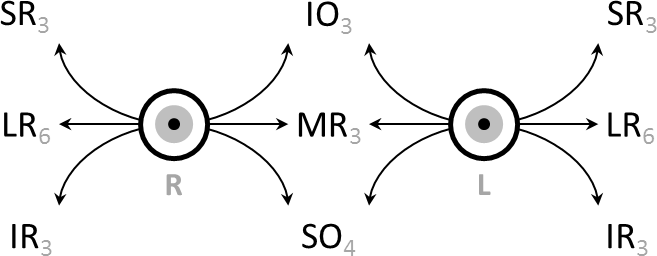
Anatomy
This was previously featured in an exam
Head and Neck
A 28 year old man presents to ED with pain and blurred vision after being hit in the eye with a fast-moving ball while playing squash. On further assessment, you find diplopia on upward gaze. Imaging shows a blow-out fracture of the inferior wall of the orbit. Which of the following muscles is most likely responsible for this finding:
Answer:
The inferior oblique and the superior rectus (both innervated by the oculomotor nerve) are normally responsible for elevation of the eyeball, but the finding in this case is due to mechanical entrapment and NOT due to nerve damage or paralysis of the extraocular muscles. The inferior rectus muscle originates from the inferior part of the common tendinous ring and inserts on the inferior anterior part of the eyeball. A blow-out fracture of the inferior wall of the orbit will likely entrap and tether the inferior rectus muscle between fragments of the broken orbital plate of the maxilla. The inferior rectus thus acts as an anchor on the eyeball, preventing upward movement of the eye.Orbital Muscles
Anatomy / Head and Neck / Orbit and Eye
Last Updated: 4th November 2019
Movements of the Eye
The six extraocular muscles are responsible for turning or rotating the eye about its vertical, horizontal, and anteroposterior axes.
Table: Movements of the Eyeball
| Action | Description | Primary Muscle(s) |
|---|---|---|
| Elevation | Moving pupil superiorly | Superior rectus and inferior oblique |
| Depression | Moving pupil inferiorly | Inferior rectus and superior oblique |
| Abduction | Moving pupil laterally | Lateral rectus |
| Adduction | Moving pupil medially | Medial rectus |
| Medial rotation (intorsion) | Rotating upper part of pupil medially towards nose | Superior oblique |
| Lateral rotation (extorsion) | Rotating upper part of pupil laterally towards temple | Inferior oblique |
Orbital Muscles
ORIGIN:
The recti muscles all originate as a group from a common tendinous ring at the apex of the orbit and form a cone of muscles as they pass forward to their attachment on the eyeball.
![By OpenStax College [CC BY 3.0], via Wikimedia Commons](https://primary-cdn.frcemsuccess.com/wp-content/uploads/2016/07/1412_Extraocular_Muscles-1024x394.jpg)
Structure of the Orbital Muscles. (Image by OpenStax College [CC BY 3.0], via Wikimedia Commons)
ACTION AND INNERVATION:
Table: Overview of the Orbital Muscles
| Extraocular Muscle | Innervation | Function | Clinical Assessment (direction to move eye when testing muscle) |
|---|---|---|---|
| Superior rectus | Oculomotor nerve | Elevation, adduction and medial rotation of eyeball | Look out and up |
| Inferior rectus | Oculomotor nerve | Depression, adduction and lateral rotation of eyeball | Look out and down |
| Medial rectus | Oculomotor nerve | Adduction of eyeball | Look in (in horizontal plane) |
| Lateral rectus | Abducens nerve | Abduction of eyeball | Look out (in horizontal plane) |
| Superior oblique | Trochlear nerve | Depression, abduction and medial rotation of eyeball | Look in and down |
| Inferior oblique | Oculomotor nerve | Elevation, abduction and lateral rotation of eyeball | Look in and up |
ASSESSMENT:
To test the muscles in isolation, the patient can be asked to move their eyeball in certain directions. A lateral position of the eyeball is necessary for testing the inferior and superior recti, whereas a medial position is necessary for testing the inferior and superior oblique. This first movement (laterally or medially) brings the axis of the eyeball into alignment with the axis of the muscle. If the extraocular muscle being tested is paralysed, the patient will be unable to perform the movement and will complain of diplopia.

Clinical Testing: Direction to Move Eye when Testing Muscles (Image by Au.yousef [CC BY-SA 4.0 (https://creativecommons.org/licenses/by-sa/4.0)], from Wikimedia Commons)
Report A Problem
Is there something wrong with this question? Let us know and we’ll fix it as soon as possible.
Loading Form...
- Biochemistry
- Blood Gases
- Haematology
| Biochemistry | Normal Value |
|---|---|
| Sodium | 135 – 145 mmol/l |
| Potassium | 3.0 – 4.5 mmol/l |
| Urea | 2.5 – 7.5 mmol/l |
| Glucose | 3.5 – 5.0 mmol/l |
| Creatinine | 35 – 135 μmol/l |
| Alanine Aminotransferase (ALT) | 5 – 35 U/l |
| Gamma-glutamyl Transferase (GGT) | < 65 U/l |
| Alkaline Phosphatase (ALP) | 30 – 135 U/l |
| Aspartate Aminotransferase (AST) | < 40 U/l |
| Total Protein | 60 – 80 g/l |
| Albumin | 35 – 50 g/l |
| Globulin | 2.4 – 3.5 g/dl |
| Amylase | < 70 U/l |
| Total Bilirubin | 3 – 17 μmol/l |
| Calcium | 2.1 – 2.5 mmol/l |
| Chloride | 95 – 105 mmol/l |
| Phosphate | 0.8 – 1.4 mmol/l |
| Haematology | Normal Value |
|---|---|
| Haemoglobin | 11.5 – 16.6 g/dl |
| White Blood Cells | 4.0 – 11.0 x 109/l |
| Platelets | 150 – 450 x 109/l |
| MCV | 80 – 96 fl |
| MCHC | 32 – 36 g/dl |
| Neutrophils | 2.0 – 7.5 x 109/l |
| Lymphocytes | 1.5 – 4.0 x 109/l |
| Monocytes | 0.3 – 1.0 x 109/l |
| Eosinophils | 0.1 – 0.5 x 109/l |
| Basophils | < 0.2 x 109/l |
| Reticulocytes | < 2% |
| Haematocrit | 0.35 – 0.49 |
| Red Cell Distribution Width | 11 – 15% |
| Blood Gases | Normal Value |
|---|---|
| pH | 7.35 – 7.45 |
| pO2 | 11 – 14 kPa |
| pCO2 | 4.5 – 6.0 kPa |
| Base Excess | -2 – +2 mmol/l |
| Bicarbonate | 24 – 30 mmol/l |
| Lactate | < 2 mmol/l |

